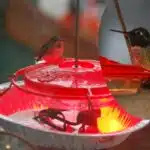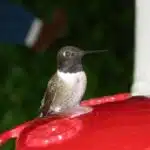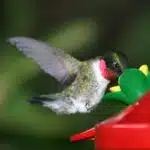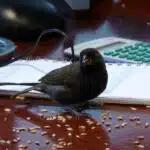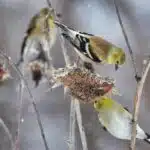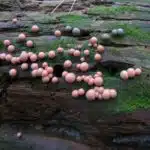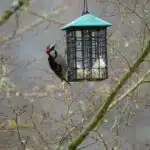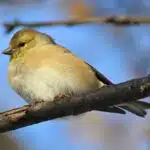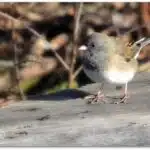As a hummingbird feeder care and cleaning expert, it is my pleasure to share with you the necessary steps for maintaining a clean and safe feeding environment for these delightful creatures. Hummingbirds are attracted to nectar, which is made from sugar and water, but the sweet liquid can quickly become contaminated if not properly cared for. In this article, I will provide you with a step-by-step guide on how to clean a hummingbird feeder, ensuring that your feathered visitors have access to fresh, healthy nectar.
Cleaning your hummingbird feeder is an essential part of maintaining the health and well-being of these tiny birds. Dirty feeders can lead to mold growth, bacteria buildup, and other harmful contaminants that can cause illness or even death in hummingbirds. By following proper cleaning techniques and regularly maintaining your feeder, you can help ensure that these fascinating creatures continue to thrive in your yard while also providing a safe and enjoyable experience for you as their caretaker. So let’s dive in and learn how to keep your hummingbird feeder sparkling clean!
Why Proper Feeder Cleaning Is Essential
As a hummingbird feeder care and cleaning expert, I must emphasize the importance of proper feeder cleaning. It is essential to maintain the health and well-being not only of the hummingbirds but also of the environment. Just like how a person needs clean water and food to stay healthy, hummingbirds require clean feeders for their sustenance.
One critical discussion idea that highlights the significance of proper feeder cleaning is health hazards. Dirty feeders can harbor harmful bacteria, mold, and fungi that can cause infections in hummingbirds. These diseases can be fatal if left untreated. Hummingbirds are also susceptible to sugar water fermentation, which attracts unwanted insects such as ants and bees. This situation poses a risk not just to the birds but also to humans who may come into contact with these insects.
Another aspect that we should explore regarding proper feeder cleaning is its environmental impact. Feeder spills and leaks contribute significantly to pollution in different ecosystems, especially when it comes to sugar water solutions that contain artificial dyes or flavors. Some of these additives can be harmful to other wildlife species that may consume them accidentally or even intentionally due to curiosity or hunger. Therefore, regular cleaning of feeders can help reduce pollution in our natural habitats while ensuring the safety of our avian friends.
By understanding why proper feeding cleaning is essential, we can delve deeper into understanding hummingbird feeding habits.
Understanding Hummingbird Feeding Habits
Proper feeder cleaning is essential to maintaining a healthy feeding environment for hummingbirds. Understanding hummingbird feeding habits is crucial in this regard, as it helps one grasp the importance of keeping hummingbird feeders clean. These tiny birds have very high metabolism rates and require frequent nectar meals to survive.
Hummingbird feeding patterns vary depending on the species and location, but they typically feed on nectar from flowers or feeders. Nectar composition is critical, as it provides the birds with the necessary nutrients and energy they need to thrive. However, if left unattended, nectar can quickly spoil, leading to fermentation and mold growth that can cause harm to the birds.
To maintain a healthy feeding environment for hummingbirds, it’s important to follow these steps:
- Clean your feeder every 2-3 days with hot water and a mild detergent.
- Rinse thoroughly with hot water to remove any soap residue.
- Refill with fresh nectar and hang in a shaded location.
As an expert in hummingbird feeder care and cleaning, I strongly advise against allowing dirty feeders to persist. The dangers of dirty feeders extend beyond just mold growth; they can also harbor harmful bacteria that can make birds sick or even lead to death. To ensure that your backyard remains a haven for these beautiful creatures, make sure you keep your feeders clean at all times.
The Dangers Of Dirty Feeders
Health risks and bacterial growth are two significant concerns when it comes to dirty hummingbird feeders. These pests can transmit diseases to the birds that can be fatal, and the stagnant nectar in the feeder serves as an ideal breeding ground for bacteria and fungi that can cause infections. The sugar in the nectar can ferment if left for too long, leading to a sour smell and taste that can deter hummingbirds from coming back.
The effects of dirty feeders on hummingbird behavior and migration patterns cannot be overlooked. Birds that consume contaminated nectar may suffer from digestive issues, dehydration, or even death. Additionally, they may become disoriented or lose their sense of direction during migration due to illness caused by ingesting harmful microorganisms. This is why it is crucial to keep your feeder clean and free of contaminants.
In summary, taking care of your hummingbird feeder’s hygiene isn’t just about maintaining its appearance; it’s also about protecting the health of these beautiful creatures. Neglecting this responsibility can lead to disastrous consequences for both you and the birds who depend on your feeder for sustenance. Therefore, in the subsequent section, we’ll explore the importance of regular maintenance to ensure your feeder remains a safe haven for our feathered friends.
The Importance Of Regular Maintenance
As we discussed in the previous section, dirty feeders can pose a significant threat to hummingbird health. It is crucial to maintain a clean feeder to ensure that these beautiful creatures remain healthy and happy. Now, let’s delve into the importance of regular maintenance and effective cleaning techniques.
Regular cleaning is necessary to prevent mold, bacteria, and yeast from growing in your feeder. These microorganisms can cause infections or other problems in hummingbirds. Therefore, it is recommended that you clean your feeders at least once every week during hot weather and once every two weeks during colder seasons.
To clean your feeder effectively, you will need warm water, white vinegar, and a bottle brush. First, disassemble your feeder carefully. Then, soak the parts in a solution of one part vinegar to four parts water for an hour or so. Afterward, use the bottle brush to scrub away any debris or residue inside or outside the feeder before rinsing thoroughly with clean water.
Now that we’ve discussed the importance of regular maintenance and effective cleaning techniques let’s move on to the materials needed for cleaning your hummingbird feeder.
Materials Needed For Cleaning
Cleaning your hummingbird feeder is an essential task that all bird lovers must do to keep their feathered friends healthy. The process of cleaning a hummingbird feeder involves the use of specific materials that are readily available in the market. To get started, you will need a cleaning solution and a cleaning brush.
A cleaning solution is critical for getting rid of any unwanted residue or bacteria that may have built up inside the feeder. You can either buy a commercial cleaning solution or make one yourself using vinegar and water. A mixture of one-part white vinegar to four parts water is an effective homemade solution that will clean your feeder without leaving any harmful chemicals behind.
In addition to the cleaning solution, you will also need a cleaning brush to reach all the nooks and crannies of your hummingbird feeder. A narrow-bristled brush with soft bristles is ideal for this task as it can easily fit into tight spaces without damaging the feeder’s delicate parts. With these materials at hand, you can now move on to disassemble the feeder and begin the cleaning process.
Step 1: Disassembling The Feeder
After gathering the necessary materials for cleaning your hummingbird feeder, it’s time to disassemble it. Removing the various parts is essential in ensuring a thorough clean and preventing mold or bacteria growth. Start by carefully taking apart the feeder, being mindful of any fragile components.
Once you have removed all of the pieces, set them aside in an organized manner to prevent any confusion when putting them back together. It’s important to note that some feeders may have more parts than others – refer to the manufacturer’s instructions if necessary. Proper storage of these parts will also help maintain their condition for future use.
To make cleaning your hummingbird feeder as easy and effective as possible, follow this 4-step process:
- Disassemble all parts of the feeder.
- Soak each piece in hot, soapy water for at least 30 minutes.
- Use a bottle brush or other soft-bristled tool to scrub away any remaining debris or residue.
- Rinse each part thoroughly with clean water and allow them to air dry before reassembling.
By following these steps, you can ensure your hummingbird feeder is properly cleaned and ready for use by our feathered friends once again!
Step 2: Soaking In Hot, Soapy Water
Hot water should be used while preparing the cleaning solution, as it helps to break down debris and residue that has built up on the feeder. The cleaning solution should include both soap and disinfectant, and the feeder should be allowed to soak for at least 20 minutes. A soft-bristled brush, sponge, or bowl can be used to scrub the feeder, followed by a thorough rinsing and drainage. Gloves, a bucket, a drain rack, and a towel should also be used to ensure a complete cleaning of the hummingbird feeder.
Hot Water
As a hummingbird feeder care and cleaning expert, I cannot stress enough the importance of soaking your hummingbird feeder in hot, soapy water. This step ensures that any residual nectar or mold buildup is effectively removed from the feeder. When using hot water, make sure it’s not too hot to touch as this can damage the plastic or glass material of the feeder.
If you’re looking for an additional step to ensure optimal cleaning, try using vinegar in your soak solution. Vinegar has natural antibacterial properties that help to kill germs and mold spores that may be present on your hummingbird feeder. Adding a small amount (1-2 tablespoons) of white vinegar to your hot, soapy water solution can be especially beneficial for feeders that are cleaned less frequently.
Cleaning frequency is another aspect to consider when soaking your hummingbird feeder in hot water. It’s recommended that you clean your feeder at least once a week during peak feeding season (spring and summer months), and every two weeks during off-seasons (fall and winter months). Soaking your feeder in hot water, along with regular cleaning, will keep it in top condition for the health and enjoyment of our feathered friends.
Soap
When it comes to the care and maintenance of hummingbird feeders, one of the crucial steps is soaking them in hot, soapy water. This process ensures that any leftover nectar or mold buildup is effectively removed from the feeder, keeping it clean and healthy for our feathered friends. But what type of soap should you use? While dish soap is a common choice, there are alternative soap options available.
If you’re looking for a more natural approach, consider using castile soap or plant-based dish soap. These eco-friendly options are free from harsh chemicals and are gentle on your hummingbird feeder. However, be cautious about using scented soaps as they may deter hummingbirds from visiting your feeder.
Another option to consider is adding vinegar to your soak solution. Vinegar has natural antibacterial properties that help kill germs and mold spores on your feeder. Adding 1-2 tablespoons of white vinegar to your hot, soapy water solution can be especially beneficial for feeders that are cleaned less frequently. Experiment with different soap options until you find one that works best for you and your feathered friends.
By using alternative soap options or adding vinegar to your soaking solution, you can ensure that your hummingbird feeder stays clean and healthy year-round. Remember to clean your feeder at least once a week during peak feeding season and every two weeks during off-seasons to maintain its condition. With proper care and cleaning, you’ll be able to enjoy watching these beautiful creatures visit your feeder for years to come!
Step 3: Scrubbing And Rinsing
Like any other object that holds liquid, hummingbird feeders can easily accumulate dirt and grime over time. Scrubbing and rinsing are essential parts of the cleaning process to ensure that the feeder is free from harmful bacteria that could harm the birds. There are different scrubbing techniques and rinsing methods suitable for various types of feeders.
For glass or plastic hummingbird feeders, a soft-bristled brush or sponge can be used to scrub the inside walls of the feeder. It is important to avoid using abrasive materials such as steel wool or harsh chemicals because they can damage the surface of the feeder and harm the birds. The same brush or sponge should be dedicated only for cleaning hummingbird feeders to prevent cross-contamination with other household items.
After scrubbing, rinse the feeder thoroughly with hot water until all traces of soap and debris are gone. Avoid using cold water since it might not be effective in removing stubborn stains and odor-causing bacteria. A thorough rinse will also help ensure that there is no soap residue left on the feeder that could harm the birds.
Maintaining a clean hummingbird feeder involves more than just filling it with fresh nectar regularly; it entails regular cleaning to prevent bacterial growth and contamination. Proper scrubbing techniques and rinsing methods are critical in ensuring that your feathered friends remain healthy and well-fed. After completing this step, you’ll be ready to move on to drying and reassembling your hummingbird feeder for future use!
Step 4: Drying And Reassembling
After scrubbing and rinsing your hummingbird feeder, it is crucial to dry it thoroughly before reassembling. Moisture left in the feeder can lead to the growth of mold and bacteria, which can be harmful to hummingbirds. The best way to dry the feeder is by air drying it.
To air dry your hummingbird feeder, place all parts on a clean towel or paper towel and leave them in a well-ventilated area for at least 24 hours. This will ensure that all moisture has evaporated from the feeder. Once completely dry, you can reassemble the feeder and refill it with fresh nectar.
In addition to drying, it’s important to sanitize your hummingbird feeder regularly with a sanitizing solution made specifically for bird feeders. This will help prevent the growth of harmful bacteria and keep your feathered friends healthy. Follow the instructions on the solution carefully and rinse thoroughly with water before air drying.
Moving forward, preventing contamination is key to maintaining a healthy feeding environment for hummingbirds. In the next section, we will provide some tips on how you can do this effectively without causing any harm or stress to these beautiful creatures.
Tips For Preventing Contamination
Preventing contamination is crucial for maintaining the health of hummingbirds. While it may seem like a simple task, there are several best practices that must be followed to ensure the feeder remains clean and safe for the birds. First and foremost, always use fresh nectar when refilling the feeder. Old and contaminated nectar can lead to mold growth, which can be harmful to hummingbirds.
One of the most common mistakes made by those caring for hummingbird feeders is not cleaning them frequently enough. It is recommended that feeders be cleaned every 3-4 days or more often in warmer weather conditions. The sugar in nectar can ferment quickly in high temperatures, leading to bacterial growth that can make hummingbirds sick. Additionally, avoid placing feeders in direct sunlight as this can accelerate fermentation.
Another important factor in preventing contamination is choosing the right type of feeder. Opt for one with removable parts that are easy to clean thoroughly, such as a glass jar feeder or a plastic feeder with detachable feeding ports. Avoid feeders with built-in perches or decorative elements that cannot be easily removed, as these areas are difficult to clean and can harbor bacteria. By following these best practices and avoiding common mistakes, you can help ensure your hummingbird feeder remains a safe and healthy source of nourishment for these beautiful birds.
To maintain a healthy environment for hummingbirds, regular cleaning is key. In the next section, we will discuss how often you should clean your feeder to prevent contamination and keep your feathered friends happy and healthy.
How Often To Clean Your Feeder
The frequency of cleaning a hummingbird feeder is dependent on the environment and can vary from weekly to monthly. To properly clean the feeder, it should be emptied and filled with warm water and soap, left to soak for a few minutes, then rinsed and scrubbed with a soft brush. Regular cleaning of the feeder reduces the risk of disease transmission, as well as mold and bacterial growth. Additionally, hummingbirds are more likely to visit a feeder that is regularly cleaned and filled with fresh nectar. Cleaning the feeder also helps to maintain a healthy nectar solution that is not contaminated by debris or other microorganisms. Finally, regular cleaning of the feeder will help ensure that the birds get the most out of their feeder visits.
How Often To Clean
Hummingbirds are beautiful creatures that many people enjoy attracting to their yards with the use of hummingbird feeders. However, owning a feeder comes with a responsibility to maintain it properly. One crucial aspect of maintaining your feeder is cleaning it regularly. The frequency of cleaning can vary depending on the climate and location, but it is recommended to clean your feeder at least once every three days.
Infrequent cleaning of your hummingbird feeder can pose several risks. The sugar solution used in the feeder can ferment and spoil quickly, leading to mold growth and bacterial contamination. These harmful substances can cause serious health problems for hummingbirds, such as fungal infections or digestive issues. Moreover, dirty feeders are attractive breeding grounds for insects such as ants or wasps, which may harm both birds and humans.
In conclusion, keeping your hummingbird feeder clean is essential for the safety and well-being of the birds that visit it. Cleaning your feeder regularly will prevent harmful bacteria and mold from growing in the nectar solution while also discouraging unwanted insects from nesting around it. By taking good care of your feeder, you ensure that hummingbirds have access to a healthy food source and create a welcoming environment for them in your backyard.
Cleaning Process
Now that we have established the importance of maintaining a clean hummingbird feeder, let us discuss the cleaning process. The first step in cleaning your feeder is to empty any remaining nectar solution and dispose of it properly. Once the feeder is empty, disassemble all its parts carefully. It is essential to follow the manufacturer’s instructions on how to take apart your specific feeder model correctly.
After disassembling, soak all parts in warm, soapy water for at least 30 minutes. Use a soft-bristled brush or sponge to scrub away any buildup or residue gently. Be sure to pay special attention to hard-to-reach areas such as feeding ports or crevices where mold or bacteria can accumulate. Rinse all parts thoroughly with hot water and allow them to dry completely before reassembling the feeder.
The frequency of cleaning your hummingbird feeder depends on several factors such as climate and location. However, regardless of these variables, it is crucial to clean your feeder at least once every three days. Moreover, if you notice any signs of mold growth or bacterial contamination, consider increasing the cleaning frequency accordingly. To ensure optimal hygiene and safety for your feathered friends, use only non-toxic cleaning solutions when washing their feeders. Remember that by taking good care of your hummingbird feeder, you provide these beautiful creatures with a healthy and safe food source they need to thrive in their natural habitat.
Benefits Of Cleaning
Maintaining a clean hummingbird feeder is crucial to the health and well-being of these tiny winged creatures. Not only does it prevent the growth of harmful bacteria and mold, but it also ensures that the nectar solution remains fresh and free from contaminants. However, how often should you clean your feeder? The answer depends on several factors such as climate, location, and the number of birds visiting your feeder.
Regular cleaning of your hummingbird feeder offers numerous benefits. Firstly, it helps prevent the spread of diseases among these delicate creatures. Hummingbirds are susceptible to various illnesses caused by contaminated food sources. By keeping your feeder clean, you reduce the risk of transmitting diseases and infections among your feathered friends. Secondly, cleaning your feeder regularly prolongs its lifespan. Over time, dirt and grime can accumulate on feeding ports or crevices leading to corrosion or damage to the plastic parts.
Apart from maintaining a healthy environment for hummingbirds, there are other benefits of cleaning your feeder frequently that should not be overlooked. A clean hummingbird feeder attracts more birds to your yard than a dirty one would. Hummingbirds have excellent eyesight and can detect even the slightest discoloration or cloudiness in their food source, resulting in them losing interest in visiting that particular feeding station. By providing them with fresh nectar every few days, you increase their chances of becoming regular visitors to your yard, offering endless opportunities for bird watching enthusiasts to observe these fascinating creatures up close and personal.
Signs Your Feeder Needs Cleaning
Frequency and prevention are key in maintaining a clean hummingbird feeder. Regular cleaning is essential to prevent mold and bacteria growth that can be harmful to these delicate birds. How often you should clean your feeder depends on various factors such as climate, location, and the number of birds visiting your feeder. As a general rule, it’s recommended to clean your feeder every three to four days during hot weather and once a week during cooler months.
One of the signs that your feeder needs cleaning is when the nectar starts to appear cloudy or has dark spots. This usually indicates the presence of mold or bacteria growth which can be harmful to hummingbirds’ health. Another sign is when you notice an unusual number of bees or wasps around the feeder. This could mean that there are spills or leaks attracting these insects. Regularly inspecting and cleaning your feeder can help prevent these issues.
Prevention is also important in keeping your hummingbird feeder clean. One way to do this is by choosing a feeder with easy-to-clean parts such as removable perches, feeding ports, and base. Use only fresh nectar mixture made from boiled water and white granulated sugar without any additives or coloring agents. Also, avoid placing the feeder in direct sunlight or near plants that attract ants or bees.
Moving onto troubleshooting common issues with hummingbird feeders…
Troubleshooting Common Issues
Clogged feeder ports are a common issue and can be easily remedied by cleaning the feeder ports with a soft-bristled brush and warm, soapy water. To avoid mouldy nectar, it is important to clean the feeder with the same solution mentioned above at least once a week and to refill the feeder with fresh nectar on a regular basis. Additionally, hanging the feeder in a location that receives direct sunlight can help to prevent mould growth. Finally, it is important to ensure the feeder lid is securely fastened to keep out any pests or debris that may contaminate the nectar.
Clogged Feeder Ports
Clogged feeder ports are a common issue that hummingbird enthusiasts face when maintaining their feeders. This problem can be caused by a number of factors including dirt, debris, and sugar build-up. If left unattended, clogged ports can prevent birds from accessing the nectar and discourage them from returning to the feeder. To avoid this issue, it is important to regularly clean your hummingbird feeder and take preventive measures.
To unclog feeder ports, there are several tips you can follow. First, remove the feeder from its hanging location and disassemble it. Soak the individual pieces in warm soapy water for at least an hour. Use a small brush or toothbrush to scrub any debris or sugar buildup off the ports before rinsing everything thoroughly with clean water. For stubborn clogs, use a thin wire or pipe cleaner to poke through the port holes.
Prevention measures are also important to keep your feeder ports clear. Start by filling your feeder with fresh nectar every few days and cleaning it on a regular basis (at least once a week). Avoid using honey or red food coloring as these substances can promote bacterial growth and clog up the ports faster. Finally, consider adding an ant moat or bee guard to your feeder to prevent unwanted insects from crawling into the nectar reservoir and causing clogs.
In conclusion, maintaining clear feeding ports is essential for attracting hummingbirds to your yard and keeping them coming back year after year. By following these unclogging tips and prevention measures, you will be able to keep your hummingbird feeder in top condition for many seasons to come!
Mouldy Nectar
Another common issue that hummingbird enthusiasts face when maintaining their feeders is the growth of mould in the nectar. Mouldy nectar not only discourages birds from feeding but also poses a health risk to them. It is important to understand the causes of mould growth and how to prevent it from happening.
The main cause of mould growth in hummingbird nectar is exposure to heat and sunlight, which promotes bacterial growth. To prevent this, it is recommended to place your feeder in a shaded area away from direct sunlight. Additionally, avoid filling the feeder with more nectar than the birds can consume in 2-3 days, as excess nectar can spoil quickly and attract insects.
If you notice mould growing in your nectar, it is essential to remove it immediately to avoid harming the hummingbirds. To do this, empty the feeder and disassemble all its parts. Wash each piece thoroughly with hot soapy water and use a brush or toothbrush to scrub away any mould or residue. Rinse everything with clean water before reassembling the feeder and refilling it with fresh nectar. Regular cleaning techniques are necessary for ensuring that your hummingbird feeder remains mold-free and safe for your little feathered friends!
Alternative Feeder Cleaning Methods
To troubleshoot common issues with hummingbird feeders, it is essential to identify the problem first. Often, the most common issue is clogging of feeding ports due to sugar buildup or mold growth. In such cases, cleaning the feeder regularly is the best solution. A clean feeder not only ensures that your little feathered friends have a fresh source of nectar but also prevents them from getting sick.
One of the most effective ways to clean a hummingbird feeder is by using a vinegar solution. Vinegar helps break down any sugar and mold buildup on the feeder’s surface while disinfecting it at the same time. To create this solution, mix one-part white vinegar with four parts of water in a basin or bucket large enough to accommodate your feeder. Allow your hummingbird feeder to soak in this mixture for about an hour before giving it a thorough rinse with hot water.
If you are looking for an alternative cleaner to vinegar, bleach can be an option; however, bleach can be harsh on both plastics and birds’ delicate digestive systems if not used correctly. To make your bleach alternative cleaning solution, mix one tablespoon of hydrogen peroxide (3%) into one cup of water and use it as you would with vinegar. This solution will help remove any stubborn stains or mold growth without harming your hummingbird feeder or endangering its intended users.
Conclusion: Happy hummingbirds await! Now that you know how to clean your hummingbird feeder effectively, all that’s left is putting these tips into practice. With regular cleaning using either vinegar or our recommended bleach alternative cleaner, you can ensure that your feathered guests have access to fresh nectar and stay healthy all year round!
Conclusion: Happy Hummingbirds Await!
Maintaining a clean hummingbird feeder is crucial to attract hummingbirds and keep them healthy. Neglecting the cleanliness of your feeder can lead to bacteria buildup, which can make the birds sick. Therefore, it is essential to regularly clean your feeder to ensure that it remains free from mold and other contaminants.
When choosing the right feeder design, opt for one that is easy to disassemble and clean thoroughly. Avoid feeders with hard-to-reach nooks and crannies as they may harbor unwanted organisms. Also, consider purchasing a feeder with an ant moat or bee guard feature to prevent insects from contaminating the nectar solution.
To properly clean your feeder, begin by disassembling it and discarding any remaining nectar solution. Rinse all parts of the feeder with hot water before soaking them in a mixture of one-part white vinegar and four-parts water for about an hour. Scrub the parts gently using a soft-bristled brush before rinsing them again with hot water. Once you have completed these steps, allow all components of the feeder to dry thoroughly before reassembling it.
- Always use fresh nectar solution when refilling your hummingbird feeder.
- Hang your hummingbird feeder in a shady area away from direct sunlight.
- Replace the nectar solution every 2-3 days during hot weather conditions.
- Clean your hummingbird feeder once a week or more frequently if you notice any signs of mold or mildew.
By following these simple steps on how to clean a hummingbird feeder, you can ensure that your feathered friends remain healthy and happy throughout their stay in your garden. Remember, regular cleaning not only keeps harmful bacteria at bay but also helps maintain the overall quality of your backyard habitat for hummingbirds.
Conclusion
Proper care and cleaning of your hummingbird feeder is essential to ensure the health and well-being of these delicate creatures. Understanding their feeding habits and the dangers of dirty feeders is crucial in maintaining a safe environment for them. Regular maintenance, such as weekly cleaning and monitoring for mold or other contaminants, is necessary to keep the feeder in good condition.
To clean your hummingbird feeder, you will need some basic materials such as soap, hot water, and a bottle brush. It’s important to pay attention to signs that indicate when your feeder needs cleaning, such as cloudy or discolored liquid, or an increase in bee activity around the feeder. Troubleshooting common issues like ants or leaky feeders can also help maintain the cleanliness of your feeder.
Alternative cleaning methods like using vinegar or boiling water can be effective for those who prefer natural solutions. Whatever method you choose, remember that a clean feeder means happy hummingbirds. As a hummingbird feeder care and cleaning expert, I urge you to take proper care of your feeder to ensure these beautiful birds continue to thrive in your backyard sanctuary.
In conclusion, maintaining a clean hummingbird feeder is crucial for the health and safety of these tiny creatures. By understanding their feeding habits and taking regular maintenance measures, you can ensure that they have a safe environment to visit for years to come. Remember – a little bit of effort goes a long way in keeping your feathered friends happy! So let’s keep those feeders sparkling clean like diamonds in the sun!
Image Credits
- “Hummingbird Feeder Heater” by skuarua (featured)


